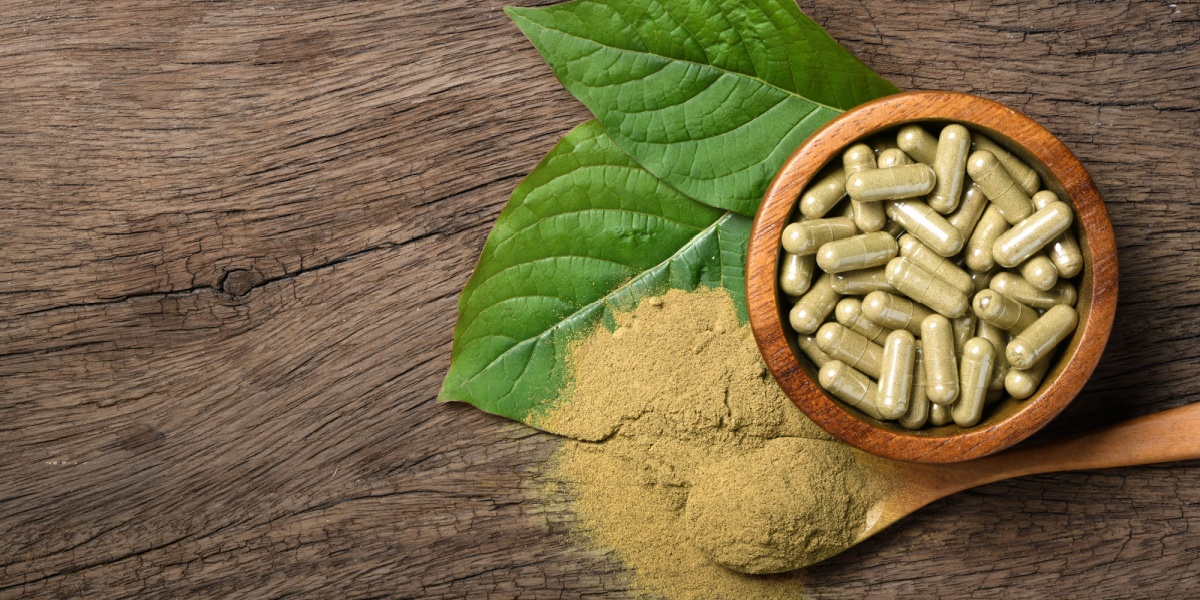Kratom is derived from the leaves of the Mitragyna speciosa tree. Commonly used in Southeast Asia, it has gained popularity in the West for its stimulant, analgesic (pain relieving), and sedative properties. [1][2] Kratom is available in many forms, some of which include powders, capsules, and teas. [1][2]
Understanding the appropriate dosage is vital for safe consumption, especially for first-time users, who are advised to start with a low dose of 2-3 capsules, each containing 0.5 grams of kratom. [1] This article explores guidelines and precautions for kratom dosing, highlighting the importance of individual factors and potential risks associated with higher doses.
Kratom does not have FDA approval to treat any medical conditions.[2]
- Kratom dosage is different for each person. This is due to the form of the kratom (powder, capsule, tea), the desired effect (pain relief, energy boost, relaxation), and individual factors of the person, like tolerance and other characteristics.
- Smaller doses of kratom have a stimulating effect, and larger doses have more sedative and analgesic effects.
- It is advised to always consult a healthcare professional before starting kratom to ensure safety.

What is kratom and what is it used for?
Kratom has been used in Southeast Asia for centuries. Mainly grown in Thailand, Malaysia, and Indonesia, the leaves of the Mitragyna speciosa tree are dried and used to make teas and powders, which are put into capsules for sale as a natural supplement. [2]
Kratom is unique in the way it works, largely because of its dose-dependent effects.[1][2][3] Lower doses tend to have more stimulant properties or effects; higher doses are more likely to cause sedation and analgesia.
Traditionally, it has been used to treat:[2]
- Fatigue
- Pain
- Diarrhea
- Muscle cramps
Kratom benefits
While research is limited, narrative reports and early studies suggest potential benefits of kratom use, which are not yet supported by the FDA: [2][4]
- Pain relief
- Mood enhancement
- Anxiety and depression treatment
- Opioid withdrawal symptom improvement
- Stimulant properties
However, there are not many evidence-based studies to determine this.
How to take kratom: Methods and dosage forms
Kratom can be taken in many ways, each affecting the dose and potential effects. It is best to always start with the lowest recommended dose.
- Kratom capsules are convenient and pre-measured, and each capsule typically contains 0.5 grams of kratom (although this may vary by brand). For beginners, starting with a low dose of 2-3 capsules (1-1.5 grams) is best to gauge tolerance and then, if needed, increase the dose based on experience with use and the desired effect.[5]
- Kratom powder can be mixed with beverages or food or can be taken directly; the dosage of kratom powder is less standardized and requires careful measurement. A survey of regular kratom users in the U.S. indicated that most people took 1-3 grams per day, with some taking 4-6 grams per day.[5]
- Kratom tea is made by brewing kratom leaves. The dosage is less precise and depends on leaf quantity and brewing time. Due to the variability in preparations, such as the amount of leaves and brewing time, dosage recommendations are not readily available. [5]
Less common methods include chewing or smoking leaves and consuming kratom extract, where the dosages are difficult to determine. Additionally, the potency may be higher with specific modes of administration (smoking, swallowing, or chewing).
What is a safe kratom dose?
Determining a safe kratom dose is challenging due to the lack of standardized products, variations in potency, and individual differences in tolerance.
The general recommendation is to start with a low dose and incrementally increase it. [1][6] A maximum recommended safe dose has not yet been established. Some anecdotal guidelines recommend not exceeding 8 grams per dose, as this will minimize the risks of nausea, dizziness, and dependency.
Kratom dosage for chronic pain relief
While the FDA has not approved kratom for medical use, some people take it to manage chronic pain. It is generally recommended to start with a low dose of 3-5 grams of red vein kratom and adjust the dose based on individual needs and responses. [5] Red vein kratom is known for its pain-relieving properties. [6]
The optimal dosage of kratom for chronic pain management can vary widely depending on individual tolerance, the specific strain used, and the severity of the pain.
Anecdotal reports and user communities have provided a general consensus on how to approach dosing for chronic pain:[6]
- Mild pain: 2-4 grams per dose
- Moderate pain: 3-5 grams per dose
- Severe pain: 5 grams or more per dose
It is important to remember that these are not clinical recommendations, as scientific research on kratom dosing remains limited. Before using kratom for chronic pain, consult a doctor to discuss potential risks and interactions with other medications.
Kratom dosage for anxiety
Unfortunately, there aren’t any clinical trials to explore the effects of kratom for managing anxiety in a controlled environment. There are, however, many survey studies and in vivo or in vitro research to help us understand if and how kratom is useful for managing anxiety disorders.
One study found that 30% of people indicated that kratom use resulted in a greater sense of well-being, with 24% of users experienced subjectively lower levels of anxiety while using kratom. [7] Another survey-based study reported overall lower levels of anxiety after using kratom — even among those not using the herb specifically to manage anxiety.[8]
Both survey studies reported greater anti-anxiety benefits in the higher dosage ranges of over 5 grams of dried powder per dose.[7][8]
However, due to the limited research on the safety and efficacy of kratom use for anxiety, approach the use with caution and seek advice from a doctor first.
Kratom dosage by strain: Red, green, and white varieties
Different strains of kratom have different effects, especially at different dosages:[1][11][12]
Red Vein Kratom: Pain relief, relaxation, and improved sleep
- 2-4 grams: Mild relaxation
- 4-6 grams: Pain relief, deeper relaxation
- 6-8 grams: Strong sedative effect
Green Vein Kratom: Balanced effects, mild pain relief, and mood enhancement:
- 1-3 grams: Slight energy boost
- 3-5 grams: Mood lift, moderate pain relief
- 5-7 grams: Sedative, relaxation
White Vein Kratom: Stimulation, focus, energy
- 1-2 grams: Gentle energy
- 2-4 grams: Mental clarity, motivation
- 4-6 grams: Strong stimulant
Once again, it is important to note that these are anecdotal reports, not based on scientific studies, and this should not be used as a dosing guide.
Kratom interactions and precautions
Just like any other substance, there are drug-drug interactions and special precautions when taking kratom. Consult a healthcare provider before using kratom, especially if you have other medications or health conditions.
Drug Interactions: [13][14][15]
- Central nervous system depressants (examples include alcohol and benzodiazepines, like valium): Their combination increases sedation risk and can cause respiratory depression.
- Stimulants (like caffeine or amphetamines, like Adderall): When taken together, they can cause overstimulation, elevated heart rate, and nervousness.
- Monoamine oxidase inhibitors (MAOIs): In combination with kratom, they may increase neurotransmitters in the brain, leading to severe side effects.
- Selective serotonin reuptake inhibitors (SSRIs) and serotonin-norepinephrine reuptake inhibitors (antidepressants): When taken with kratom, there is an increased risk of serotonin syndrome.
- Pregnancy & breastfeeding: It may cause withdrawal symptoms in newborns (as in neonatal abstinence syndrome), and its safety during breastfeeding is unclear. Thus, taking kratom is not recommended.
- Liver problems: There have been reports of liver injury, so people with liver issues should use kratom with caution.
- Dependence and withdrawal: Long-term kratom use can lead to dependence and withdrawal symptoms upon cessation that cause irritability and insomnia, among others.
Kratom overdose
Kratom overdose, although rare, can occur at high doses, especially if it is mixed with other substances. Potential risks include the following adverse effects: [9][18]
- Nausea
- Vomiting
- Dizziness
- Drowsiness
- Rapid heartbeat
- Seizures
- Respiratory depression
- Liver damage
- Coma
- Death (although rare, death is linked to kratom and polydrug use)
Combining kratom with other depressants (like opioids or alcohol) increases overdose potential and the likelihood of life-threatening effects.
FDA regulations and warnings on kratom use
The FDA has issued several warnings about the use of kratom, has not approved kratom for any medical use, and has expressed concerns about its safety: [9]
- Health risks such as liver toxicity, seizures, dependence, or death (rare, but especially in cases in conjunction with other substances)
- Possible product contamination with salmonella or heavy metals
The FDA considers kratom a "drug of concern." In addition, the FDA issued warning letters to companies illegally marketing kratom products with unproven claims about treating or curing medical conditions, like opioid use disorder and withdrawal symptoms.[10]
Other safety concerns include inconsistencies in the quality, purity, and potency of some kratom products. [3] Yet, despite this, kratom remains legal in the U.S., although it is controlled or banned in some other countries.[2]

-person-thumbnail.jpg?v=1758880627)


